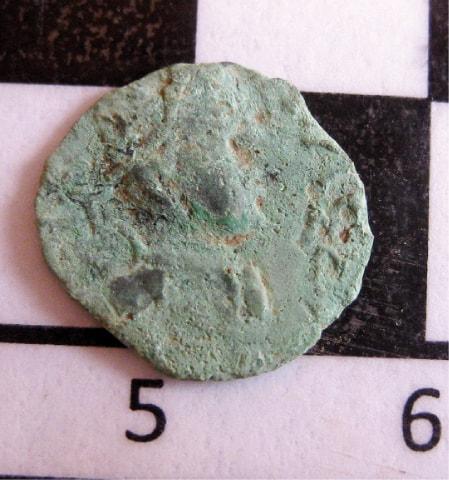Amjad Iqbal
Source - http://www.dawn.com/news/1242553/mughal-era-coin-longest-staircase-unearthed-near-ban-faqiran?

 Copper coin from the Mughal era. The other picture is of the site of Ban Faqiran Buddhist stupa and monastery dating back to 200-500AD. — Photos by the writer
Copper coin from the Mughal era. The other picture is of the site of Ban Faqiran Buddhist stupa and monastery dating back to 200-500AD. — Photos by the writer
During an excavation at a Buddhist stupa in Ban Faqiran, archaeologists from the Federal Department of Archaeology have discovered rare antiques, including a copper coin from the Mughal era.
Also unearthed was a staircase longer than anything yet discovered in Gandhara and Taxila.
The discoveries could mean a rewriting of the history of the federal capital.
The director general of the department, Dr Mohammad Arif, revealed that the remains of a mosque, the oldest in Islamabad, are situated some 200 metres west of the stupa - inside Islamabad Capital Territory - and is made of lime and kanjur stone.
The mosque was, until now, believed to be from the Ghaznavi period. However, recent excavations indicate that it was built in the Mughal era as the only coin unearthed is also from the Mughal era.
The coin is believed to have belonged to Shah Alam, one of the sons of Emperor Aurangzeb.
Dr Arif also told Dawn about another ‘remarkable’ discovery, one of a staircase in the stupa, believed to be the longest staircase in Gandhara and Taxila valley.
The stupa is from the Kushan period, between 200 and 400AD and is located about two kilometres from the Giri Buddhist monastic complex in Taxila Valley, and two kilometres from the Shah Allah Ditta caves in Islamabad, Dr Arif said.
He said the preliminary excavation exposed the archaeological remains of the colossal Buddhist structure, which measures 10.15 by 26 metres. The base of the stupa is made of lime and kanjur stone, with semi ashlar and diaper masonry dating back to somewhere between the 2nd and the 4th century CE.
The base was originally coated with lime plaster, and the drum of the stupa is made of kanjur stone extracted from the Shah Allah Ditta caves.
He said the exposed architecture of the stupa presented masonry similar to that done during the reconstruction of the Dharmarjika Stupa in Taxila, which dates back to the 3rd century AD, as well as the Bhamala and Badalpur stupas.
In response to a question, he said this was the first excavation project conducted by the department in Islamabad since its establishment. Funds for the excavation and preservation of the site were provided by the National Fund for Cultural Heritage in April 2015, he added.
Dr Arif explained that the excavations were led by a senior archaeologist from the department who has previously conducted successful excavations in Jinnan Wali Dheri, Badalpur in Taxila, Pir Mankral, Haripur, Zar Dheri in Mansehra, Harrapa in Punjab and Nowsharo in Balochistan.
Abdul Ghafoor Lone, who led the excavation, told Dawn that other than the structural remains of the stupa, 11 rare coins from the Indo-Greek, Kushan and Mughal periods were also discovered.
Four arrowheads made of iron and shreds of terracotta pots were also unearthed.
He said the excavation had exposed hidden cultural treasures and had verified the hypotheses of various senior archaeologists regarding Islamabad’s cultural heritage, with particular emphasis on the Ban Faqiran remains.
He added that the recent discoveries had extended Islamabad’s cultural history, which previously went as far back as the 15th century AD, with the discoveries of the Pharwala Fort and Rawat Fort, as well as the late Mughal era Saidpur Village.
Mr Lone said that a detailed survey could help save the city’s endangered cultural heritage and environment, and a project for this purpose has been submitted to the concerned authorities for their approval.